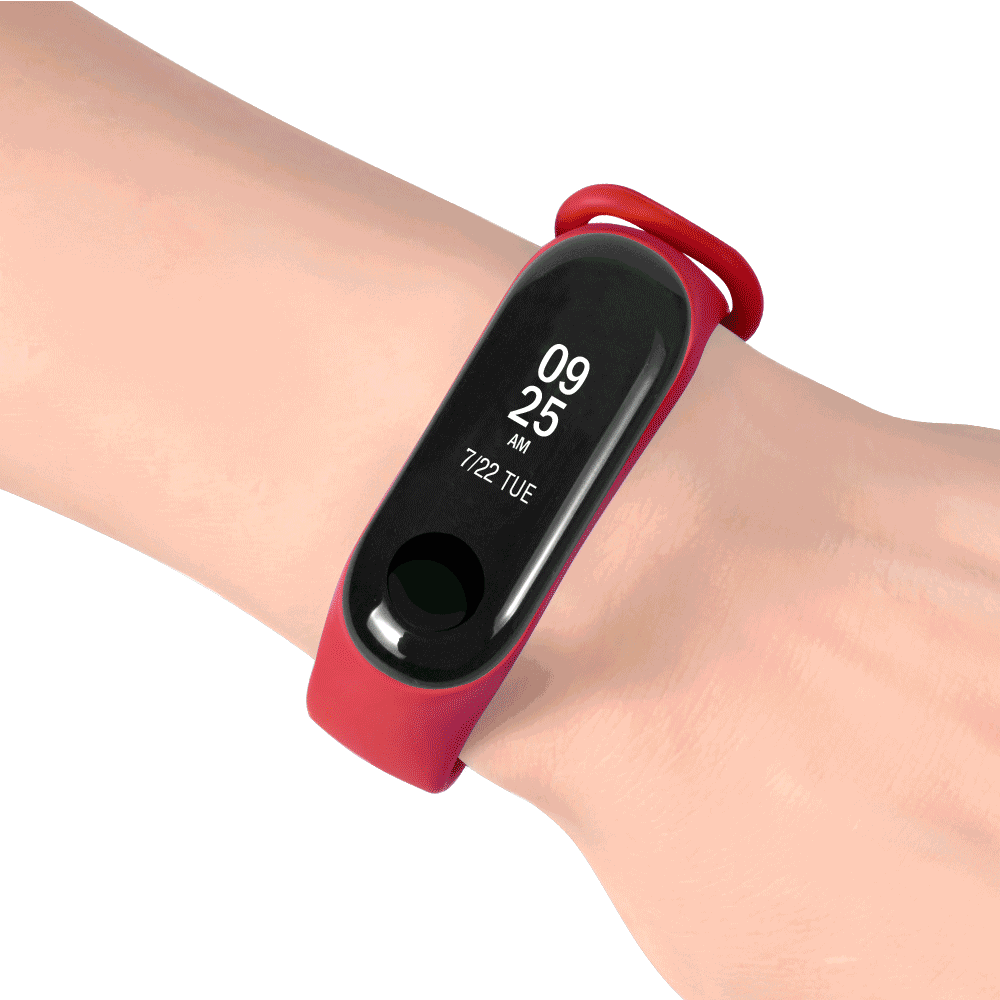Wearable devices, such as smart bracelets, children's positioning smart bracelets, smart watches and other popular, this type of wearable products, many of them use silicone as raw materials.
The shortcomings of silicone.
1. requires oil pressure molding, long production cycle and low productivity.
2. secondary materials (such as trimmings, waste materials) can not be recycled.
It is worth noting that the excellent characteristics of thermoplastic elastomer TPE, so that it began to gradually win the attention of the smart wear field and pro-eye.
TPE relative to silicone: fast production, high production efficiency; edge material can be recycled repeatedly.
TPE has a wider range of hardness options (0~100A), and TPE has a softer touch close to the skin.
TPE blending system has better compatibility (blending modification), easy to adjust the characteristics of the material. At present, TPEs that are more suitable for smart wear (bracelets, wristbands, watch bands) industry have been developed. These TPE materials have excellent elasticity closer to silicone, and the surface is softer and smoother. In addition, the surface is not easy to stick to dust, excellent antistatic properties, and has excellent anti-fouling properties. The choice of other blending systems also takes full account of environmental safety (skin safety and non-allergenic).
Different wearable devices, the characteristics and hardness of the TPE materials used are different, usually the hardness range of 50 ~ 80A. As mentioned above, TPE blending system has very good compatibility. composite molding).
In the past one or two years, smart wearable devices have been a leading fashion field. Such a popular industry will naturally lead to various grades of smart wearable products competing to meet the needs of different consumer markets. Considering the characteristics and cost of TPE materials, TPE can be positioned as the preferred raw material for mid- to high-end wristbands.
In terms of perspective, the premise of a bracelet that can be worn continuously is comfort. What is comfort? The first is the skin-friendly material, followed by the weight, and then it is also important that the ingredients are harmless. After more than enough time to wear, we think Xiaomi bracelet 4 still inherited the series of non-sensory wearing comfort, to meet the many requirements of the above comfortable experience, this is still a comfortable sports attributes full of bracelet products.
First of all, in the wristband part, the material of Xiaomi Band 4 is soft to the touch, and the TPU material it uses has passed the ISO-10993-5/10 biocompatibility certification and European RoHS environmental certification, which generally does not cause skin allergies. The most praiseworthy part is that the Xiaomi Band 4's clasp is stronger than previous generations, and when using it as a new product, you even need to use a larger force to fix it, which is very tight.

The weight of the Xiaomi Band 4 is only 22.4g (including the wristband), a reduction of 1/4 compared to its predecessor's weight of 30g. The weight of the Xiaomi Band 4 is similar to that of a No. 5 battery, and with the soft, skin-friendly TPU wristband, its presence is barely perceptible in everyday wear. Compared to the first three generations of the bracelet, Xiaomi Band 4 has made a leap forward in terms of wearability, and a further 1/4 weight reduction allows you to put it on and forget about it, tangible to intangible transformation.
Users of the first three generations of the Xiaomi Band should feel the simplicity of the three sports functions - they can only provide information on heart rate, steps and other activities, but also monitor sleep, for more sports needs can not be met. The Xiaomi Band 4 makes up for this shortcoming by being equipped with 6-axis motion sensors: 3-axis acceleration sensor + 3-axis gyroscope, the former is responsible for sensing front and back, left and right up and down (three-dimensional space), and the 3-axis gyroscope is to sense the dynamic information of left and right tilt, front and back tilt, and left and right sway respectively.
Xiaomi Mi Band 4 also supports 5 ATM level waterproof (can be worn in the shower, swimming pool and shallow swimming, but not for sauna and diving.) It supports six sports modes: swimming, outdoor running, indoor running, walking, exercising, and cycling. Thanks to the Xiaomi Band 4's built-in six-axis sensor, the Xiaomi Band 4 can intelligently identify the five swimming strokes of freestyle, breaststroke, backstroke, butterfly, and medley while the user is swimming, and track 12 professional swimming data in real time, such as speed and stroke rate, and can give professional advice and adjust the user's swimming style based on the user's own swimming data.
Each sports sub-section can be opened through the bracelet itself and the mobile app, but it should be noted that since the Xiaomi bracelet 4 does not have a built-in GPS module, you must remember to open the GPS positioning on your phone before starting outdoor walking, outdoor running and other sports items. At the end of the campaign, Xiaomi Band 4 can record five core data to help improve the efficiency of future walking. In addition, the Xiaomi Band 4 provides professional advice to users to reduce sports injuries by tracking the user's running pace and speed data during running. The other workout mode and cycling also record the heart rate and calories burned during exercise. After each exercise, in the Xiaomi Sports App can see the data classification and graph summary of the exercise, more intuitive understanding of their exercise status. Xiaomi Band 4 still supports heart rate warning. When the heart rate is too high, the bracelet will automatically vibrate to remind users to pay attention to, in addition to sedentary reminders and other functions are still based on heart rate monitoring to achieve.
Xiaomi Band 4 NFC version has an additional NFC function compared to Xiaomi Band 4, which is an important difference between the two. Currently, the Xiaomi Band 4 NFC version supports 14 bus cards, 187 city bus and access cards across the country (access cards do not include encryption cards). Like its predecessor, the Xiaomi Mi Bracelet 4 NFC version is still the NFC bracelet that supports the most transportation cards, allowing for over-the-air card issuance and over-the-air recharge functions. Although many NFC bracelets currently on sale claim to support public transport card function, but the number of cities supported is relatively small or even limited to a few first-tier cities. The Xiaomi Band 4 NFC version relies on its long-established Xiaomi bus function, supporting the bus card function in more than 160 cities, including Beijing, Shenzhen and Guangzhou. According to our understanding of the previous generation of the bracelet, it currently supports at least Beijing-Tianjin-Hebei interoperability card, Guangdong Province Lingnan Pass, Shenzhen Pass, Hefei Pass, Jiangsu One Card. Suzhou, Wuhan pass, Jilin pass, Guangxi traffic a card.
The simulated access card function has finally ended its experimental phase, and when we reviewed the Xiaomi Band 3 NFC version, we also found that it was closed by default in the secondary menu within the "Lab Features", but here it was finally put out in a prominent position on the home page. Like its predecessor, the Xiaomi Band 4 NFC version currently only supports unencrypted and 13.56MHz gate cards on the market. In addition, with the door card function of the bank card and stored value consumption, public transport consumption function of the door card can not be simulated for the time being. Even if the simulation is successful, these cards do not have the functions of banking and public transportation.
The Xiaomi Band 4 has a larger screen, from a black and white screen to a color screen, which is bound to be more power hungry than its predecessor. However, fortunately, the Xiaomi Band 4 / Xiaomi Band 4 NFC version are built-in 135 mAh battery, compared to 110 mAh in the 3rd generation is 25 mAh larger, for the battery life has a good supplement. The Xiaomi Mi Band 4 NFC Edition has 58% battery left in the box and has been used for about 20 hours. The heart rate, hand raised bright screen has been turned on, the phone and the bracelet are always connected. After 20 hours, the remaining power is 52%, and 6% of the power is consumed. In the case of a full charge, it basically meets the official claim that the Xiaomi Band 4 NFC version lasts about 15 days. As for the standard version of the Xiaomi Band 4, because there is no NFC module, a major power consumer, under the same conditions, the battery life of more than 20 days is not a big problem.
The first thing worthy of praise is that the Xiaomi Band 4 generation has finally ended the black and white world that stretched over three generations before, bringing an upgraded full-color AMOLED high-brightness screen with a screen resolution that directly improves the viewing experience by 2 times and a pixel density of 193 PPI, making the eye quite comfortable and pleasing. In addition to that very recognizable color screen in the bright screen, its overall change in appearance is not too big, basically the same as the Xiaomi Mi Bracelet 3 generation, even the wristband can be commonly replaced with each other. Naturally, the old tradition of taking down the rice grains for charging has also been retained, as the new hand rice grains and wristband articulation is indeed as solid as the third generation, perhaps reducing the embarrassment of the first two generations "strap is still there, the rice grains are gone". However, the daily charging inevitably often remove the rice grain deduction, over time still can not avoid the rice grain loose, here I hope that the future Xiaomi bracelet products can consider the magnetic charging design to reduce the frequency of disassembly of the rice grain.
The most noteworthy thing is that the Xiaomi Band 4 NFC version in addition to a comprehensive hardware upgrade, but also access to Ai classmates, you can feel "a word of business" to set the alarm, heart rate, start sports, open Alipay, open the bus card and a series of complicated matters. The wrist Ai classmates can also be interconnected with the Mijia smart home, becoming another entrance to the smart home. In terms of battery life, the Xiaomi Band 4 uses a larger screen, from black and white screen to color screen, is bound to be more power hungry than its predecessor. The 4 generation is not too big compared to the 3 generation's appearance, the change in the outside of the battery life, but the upgrade in the screen, function, especially the wrist Ai classmates for Xiaomi's own wearable product line is epoch-making.
Overall, the Xiaomi Band 4 is more like the appearance of the Xiaomi Band 3, but in the hardware and software for its own comprehensive epoch-making upgrades. The most important thing is that the Xiaomi Band 4 standard edition starts at 169 yuan and the Xiaomi Band 4 NFC edition starts at 229 yuan, continuing Xiaomi's usual high cost performance. On the basis of such a price, Xiaomi Band 4 is such an excellent wearable device that it will certainly be like the previous generations to recreate the explosion.




